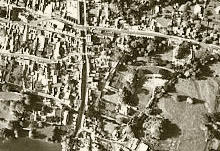|
 On becoming King of England
in January 1066 Harold II prepared his country's defences for war,
undaunted by the ill-omened appearance in the sky of Halley's Comet.
At the core of the army Harold and his earls had highly-trained
warriors from their own households. In addition, Harold had a large
fleet of ships which in May 1066 repelled a raid on the south coast by
his embittered brother Tostig. England had no castles, but there were
fortified towns and other strong points including a number of Roman
forts. The first serious challenge to Harold's rule came from King
Harald Hardrada of Norway who, in September 1066, allied with Tostig,
sailed 300 ships up the River Humber. The Norsemen defeated an English
army at Fulford outside York, but a few days later King Harold arrived
to defeat Harald Hardrada at Stamford Bridge leaving both him and
Tostig dead. No sooner was Harold victorious, however, than he heard
of Duke William of Normandy's landing some 400km away on the south
coast and hastened to meet him. On becoming King of England
in January 1066 Harold II prepared his country's defences for war,
undaunted by the ill-omened appearance in the sky of Halley's Comet.
At the core of the army Harold and his earls had highly-trained
warriors from their own households. In addition, Harold had a large
fleet of ships which in May 1066 repelled a raid on the south coast by
his embittered brother Tostig. England had no castles, but there were
fortified towns and other strong points including a number of Roman
forts. The first serious challenge to Harold's rule came from King
Harald Hardrada of Norway who, in September 1066, allied with Tostig,
sailed 300 ships up the River Humber. The Norsemen defeated an English
army at Fulford outside York, but a few days later King Harold arrived
to defeat Harald Hardrada at Stamford Bridge leaving both him and
Tostig dead. No sooner was Harold victorious, however, than he heard
of Duke William of Normandy's landing some 400km away on the south
coast and hastened to meet him.
 William
had raised a substantial army in Normandy which embarked on 27th
September and landed near Hastings. At the battle of Hastings on 14th
October William was victorious and Harold was killed. After his
victory William made for London and was crowned king on Christmas Day.
William ruthlessly replaced the English aristocracy by his own men and
his forces controlled England by building castles at strategically
important places. The most serious opposition to William came in 1069
when a rebellion centred on York was supported by a Danish army.
Unrest in the north provided an opportunity for the King of Scotland
to raid England, but he was forced to submit to William in 1072. William
had raised a substantial army in Normandy which embarked on 27th
September and landed near Hastings. At the battle of Hastings on 14th
October William was victorious and Harold was killed. After his
victory William made for London and was crowned king on Christmas Day.
William ruthlessly replaced the English aristocracy by his own men and
his forces controlled England by building castles at strategically
important places. The most serious opposition to William came in 1069
when a rebellion centred on York was supported by a Danish army.
Unrest in the north provided an opportunity for the King of Scotland
to raid England, but he was forced to submit to William in 1072. |